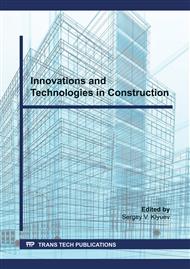[1]
N.S. Astafyeva et al., Protection of underground parts of buildings and structures from the impact of underground water, Regional development. 3-4 (2014) 202-205.
Google Scholar
[2]
V. Vitiello, R. Castelluccio and M. Del Rio Merino, Experimental research to evaluate the percentage change of thermal and mechanical performances of bricks in historical buildings due to moisture, Construction and Building Materials. 244 (2020) 118107.
DOI: 10.1016/j.conbuildmat.2020.118107
Google Scholar
[3]
N.I. Gusev, M.V. Kochetkova and K.S. Parshina, From the experience of restoration of old buildings, Regional architecture and construction. 1 (2014) 128-131.
Google Scholar
[4]
E.V. Belanovskaya, Restoration and fundamentals of restoration of stone architectural monuments, Monograph, ASV Publishing house, Moscow, (2013).
Google Scholar
[5]
R.A. Khachatryan and K.A. Lapunova, Features of restoration of brick buildings, in: A.V. Avdeev, Rainbow of Knowledge: theoretical and practical aspects of science, Sphere, Rostov-on-don, 2017, pp.81-85.
Google Scholar
[6]
O.S. Subbotin, Features of using building materials in the restoration of architectural and town-planning heritage, Construction Materials and Products. 2(3) (2019) 85-89.
DOI: 10.34031/2618-7183-2019-2-3-85-89
Google Scholar
[7]
S. Chernyshev, I. Rubtsov and E. Elmanova, Innovative technologies in brick masonry restoration of architectural monuments, MATEC Web of Conferences. 193 (2018) 04007.
DOI: 10.1051/matecconf/201819304007
Google Scholar
[8]
N. Cobîrzan et al., Microscopical and macroscopical analysis of recovered bricks for assessing their reusability in masonry buildings, Procedia Manufacturing. 46 (2020) 144-149.
DOI: 10.1016/j.promfg.2020.03.022
Google Scholar
[9]
D. Dobias et. al., Influence of partial replacement of hydraulic binder by ground brick on the characteristics of composites, Procedia Engineering. 190 (2017) 568-574.
DOI: 10.1016/j.proeng.2017.05.381
Google Scholar
[10]
I. Aalil, D. Badreddine, K. Beck, (...), A. Chaaba and M. Al-Mukhtar, Valorization of crushed bricks in lime-based mortars, Construction and Building Materials. 226 (2019) 555-563.
DOI: 10.1016/j.conbuildmat.2019.07.265
Google Scholar
[11]
Ali A. Aliabdo et. al., Utilization of crushed clay brick in concrete industry, Alexandria Engineering Journal. 53 (2014) 151-168.
DOI: 10.1016/j.aej.2013.12.003
Google Scholar
[12]
J. Dang, J. Zhao, S.D. Pang and S. Zhao, Durability and microstructural properties of concrete with recycled brick as fine aggregates, Construction and Building Materials. 262 (2020) 120032.
DOI: 10.1016/j.conbuildmat.2020.120032
Google Scholar
[13]
V.E. Danilov, D.V. Ershkov and А.М. Ayzenshtadt, The aspect of color optimization of the mineral repair mixture for the brickwork restoration, in: S. Klyuev, V. Lesovik, N. Vatin (Eds.), Innovations and Technologies in Construction, BUILDINTECH BIT 2020, Lecture Notes in Civil Engineering, Springer, Cham., vol 95, 2021, https://doi.org/10.1007/978-3-030-54652-6_19.
DOI: 10.1007/978-3-030-54652-6_19
Google Scholar
[14]
V.S. Lesovik, L.H. Zagorodnyuk, D.A. Belikov, A.Yu. Shchekina and A.A. Kuprina, Effective dry mixes for repair and restoration work, Constr. Mater. 7 (2014) 82-85.
Google Scholar
[15]
I.L. Chulkova, Possibility of using dry mixes for the restoration and reconstruction of ancient limestone objects based on the similarity law of structures, Bulletin of the Siberian State Automobile and Road Academy. 6(34) (2013) 66-72.
Google Scholar
[16]
V.S. Lesovik, I.L. Chulkova, L.K. Zagordnyuk, A.A. Volodchenko and P.D. Yurievich, The role of the law of affinity structures in the construction material science by performance of the restoration works, Research Journal of Applied Sciences. 9(12) (2014) 1100-1105.
Google Scholar
[17]
V.E. Danilov, V.V. Strokova and A.M. Ayzenshtadt, Role of dispersion and polarization effects in the formation of a wood-mineral composite based on fine-dispersed components, Phys. Chem. Mater. Process. 4 (2018) 50-56.
Google Scholar
[18]
V.E. Danilov, A.M. Ayzenshtadt, M.A. Frolova and A.S. Tutygin, Change in surface energy - a criterion for optimizing the composition of a cementless composite binder, Mater. Sci. 2 (2018) 39-44.
Google Scholar
[19]
Y.V. Sokolova, A.M. Ayzenshtadt, V.V. Strokova and V.S. Malkov, Surface tension determination in glyoxal-silica dispersed system, Journal of Physics: Conference Series. 1038(1) (2018) 012141.
DOI: 10.1088/1742-6596/1038/1/012141
Google Scholar


